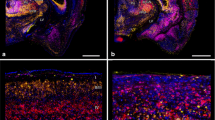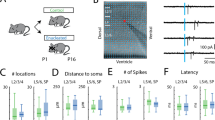Summary
Tectal ablation in neonatal rats leads to retrograde degeneration of retinal ganglion cells whereas similar damage in adults does not. We show here that the behavioral effects are comparably different. When rats with neonatal tectal ablation are tested as adults they are impaired in learning a discrimination between vertical and horizontal stripes and their visual acuity for square-wave gratings is slightly but significantly reduced.
Similar content being viewed by others
References
Birch D, Jacobs GH (1979) Spatial contrast sensitivity in albino and pigmented rats. Vision Res 19: 933–937
Cowey A, Franzini C (1979) The retinal origin of uncrossed optic nerve fibres in rats and their role in visual discrimination. Exp Brain Res 35: 443–455
Dean P (1978) Visual acuity in hooded rats: Effects of superior collicular or posterior neocortical lesions. Brain Res 156: 17–31
Dean P (1981) Visual pathways and acuity in hooded rats. Behav Brain Res 3: 239–271
Goodale MA, Milner AD (1982) Fractionating orientation behaviour in the rodent: The role of the superior colliculus. In: Ingle D, Goodale MA, Mansfield R (eds) Advances in the analysis of visual behaviour. MIT Press, Cambridge, in press
Hughes A (1977) The topography of vision in mammals of contrasting life style: comparative optics and retinal organisation. In: Crescitelli F (ed) The visual system in vertebrates. Springer, Berlin Heidelberg New York (Handbook of sensory physiology, vol VII/5, pp 613–756)
Lashley KS (1930) The mechanism of vision. III. The comparative visual acuity of pigmented and albino rats. J Gen Psychol 37: 481–484
Perry VH, Cowey A (1979a) The effects of unilateral cortical and tectal lesions on retinal ganglion cells in rats. Exp Brain Res 35: 85–95
Perry VH, Cowey A (1979b) Changes in the retino-fugal pathways following cortical and tectal lesions in neonatal and adult rats. Exp Brain Res 35: 97–108
Perry VH, Cowey A (1982) A sensitive period for ganglion cell degeneration and the formation of aberrant retino-fugal connections following tectal lesions in rats. Neuroscience 7: 583–594
Schneider GE (1979) Is it really better to have your brain lesion early? A revision of the “Kennard Principle”. Neuropsychologia 17: 557–583
So K-F, Schneider GE, Ayres S (1981) Lesions of the brachium of the superior colliculus on neonate hamsters: Correlation of anatomy with behaviour. Exp Neurol 72: 397–400
Wiesenfeld Z, Branchek T (1976) Refractive state and visual acuity in the hooded rat. Vision Res 16: 823–827
Author information
Authors and Affiliations
Additional information
Supported by MRC grant G 971/397/B
Rights and permissions
About this article
Cite this article
Cowey, A., Henken, D.B. & Perry, V.H. Effects on visual acuity of neonatal or adult tectal ablation in rats. Exp Brain Res 48, 149–152 (1982). https://doi.org/10.1007/BF00239583
Received:
Accepted:
Issue Date:
DOI: https://doi.org/10.1007/BF00239583




